#Australia-Data-Provider
Explore tagged Tumblr posts
Text
Choosing the Right Data Vendor for Your Business in Australia
In today's data-driven world, businesses of all sizes rely on data to make informed decisions, drive growth, and gain a competitive edge. Whether you are a startup or a well-established company in Australia, finding the right data vendor is crucial to ensure that you have access to accurate, relevant, and up-to-date data. However, with a plethora of data vendors to choose from, making the right choice can be a daunting task. This article aims to guide you through the process of selecting the right data vendor for your business in Australia.

Understanding Your Data Needs
Before you start evaluating data vendors, it's essential to have a clear understanding of your data needs and objectives. Take the time to answer the following questions:
What type of data do you require? Data can be categorized into various types, including demographic, financial, geographic, market, and more. Determine the specific data types that are relevant to your business.
How much data do you need? Consider the volume of data required to support your operations and decision-making processes. Are you looking for real-time data, historical data, or a combination of both?
What is your budget? Data services come with varying price tags. Establish a budget for your data needs, taking into account the quality and quantity of data required.
Do you need data enrichment services? Some data vendors offer data enrichment services, which can help you enhance your existing customer data with additional information.
What are your data privacy and compliance requirements? Ensure that the data vendor you choose complies with data privacy regulations in Australia, such as the Privacy Act 1988.
How will you use the data? Consider how the data will be integrated into your existing systems and how it will be used to achieve your business objectives.
By answering these questions, you'll have a clearer picture of your data needs, making it easier to evaluate potential data vendors.
Researching Data Vendors
Once you have a clear understanding of your data requirements, it's time to research potential data vendors. Here are some key factors to consider during your research:

1. Reputation and Reliability
Start by researching the reputation and reliability of data vendors. Look for customer reviews, testimonials, and case studies to gauge their track record. Reliable data vendors should have a history of delivering accurate and timely data.
2. Data Quality
Data quality is paramount. Verify the quality of the data provided by a vendor through sample data sets and data accuracy guarantees. Accurate data is essential for making informed decisions.
3. Data Sources
Understand where the data vendor sources its data. Is the data collected from reputable sources, and is it regularly updated? A diverse range of data sources can provide a more comprehensive view of your target market.
4. Data Customization
Choose a vendor that allows you to customize your data package to match your specific needs. This flexibility ensures that you're not paying for data you don't require.
5. Data Security and Compliance
Ensure that the data vendor adheres to strict data security measures and complies with relevant data privacy regulations in Australia. Data breaches can have severe consequences, so security should be a top priority.
6. Scalability
Consider your future data needs. Will the chosen vendor be able to scale their services as your business grows? Scalability is crucial for long-term partnerships.
7. Data Delivery and Integration
Evaluate how the vendor delivers data. Can data be seamlessly integrated into your existing systems? Look for vendors that offer APIs or data feeds for easy integration.
8. Customer Support
Excellent customer support is essential, especially if you encounter issues or have questions about the data. Test the responsiveness of a vendor's support team before committing to their services.
Evaluating Costs
Cost is a significant factor when choosing a data vendor. However, it's important not to sacrifice data quality and reliability for the sake of a lower price. Consider the following cost-related factors:
1. Data Pricing Model
Different vendors may have varying pricing models, such as pay-as-you-go, subscription-based, or tiered pricing. Choose a model that aligns with your budget and data usage.
2. Hidden Costs
Be wary of hidden costs, such as fees for data updates, data enrichment, or API access. Ensure that you fully understand the cost structure before signing any agreements.
3. Return on Investment (ROI)
Assess the potential ROI of using a particular data vendor. Will the data you receive enable you to make more informed decisions and drive revenue growth that outweighs the cost of the data service?
Making the Final Decision
After thorough research and evaluation, it's time to make your final decision. Here are some additional tips to help you choose the right data vendor:
1. Trial Period
If possible, opt for a trial period with the vendor. This allows you to test the data quality, integration process, and overall compatibility with your business needs before committing.
2. Seek Recommendations
Ask for recommendations from industry peers or consult with experts in the field. They may have insights into reputable data vendors that are a good fit for your industry.
3. Negotiate Terms
Don't hesitate to negotiate terms and pricing with the data vendor. They may be willing to customize a package that better suits your requirements.
4. Review Contracts Carefully
Before signing any contracts, carefully review all terms and conditions, including data usage rights, termination clauses, and data ownership.
5. Establish a Data Governance Plan
Once you've selected a data vendor, develop a data governance plan within your organization to ensure that data is used effectively and responsibly.
Conclusion
Choosing the right data vendor for your business in Australia is a critical decision that can significantly impact your success. By understanding your data needs, thoroughly researching potential vendors, evaluating costs, and following best practices, you can make an informed choice that aligns with your business goals. Remember that data is a valuable asset, and partnering with the right data vendor can give your business a competitive advantage in the Australian market.
0 notes
Text
Transform Your Business with Pixid.ai Data Engineering Services in Australia
Transform Your Business with Pixid.ai Data Engineering Services in Australia
Data engineering is essential for transforming raw data into actionable insights, and Pixid.ai stands out as a leading provider of these services in Australia. Here’s a comprehensive look at what they offer, incorporating key services and terms relevant to the industry
Data Collection and Storage
Pixid.ai excels in big data engineering services in Australia and New zealand collecting data from various sources like databases, APIs, and IoT devices. They ensure secure storage on cloud platforms or on premises servers, offering flexible cloud data engineering services in Australia tailored to client needs.
Data Processing
Their data processing includes cleaning and organizing raw data to ensure it’s accurate and reliable. This is crucial for effective ETL services in New zealand and Australia (Extract, Transform, Load), which convert raw data into a usable format for analysis.
Data Analysis and Visualization
Pixid.ai employs complex analytical algorithms to detect trends and patterns in data. Their big data analytics company in Australia and New Zealand provides intelligent research and generates visual representations like charts and dashboards to make difficult data easier to grasp. They also provide sentiment analysis services in New zealand and Australia, helping businesses gauge public opinion and customer satisfaction through data.
Business Intelligence and Predictive Analytics
Their robust data analytics consulting services in New zealand and Australia include business intelligence tools for real time performance tracking and predictive analytics to forecast future trends. These services help businesses stay proactive and make data-driven decisions.
Data Governance and Management
Pixid.ai ensures data quality and security through strong data governance frameworks. As data governance service providers in Australia and New zealand they implement policies to comply with regulations, maintain data integrity, and manage data throughout its lifecycle.
Developing a Data Strategy and Roadmap
They collaborate with businesses to develop a comprehensive data strategy aligned with overall business goals. This strategy includes creating a roadmap that outlines steps, timelines, and resources required for successful data initiatives.
Specialized Consulting Services
Pixid.ai offers specialized consulting services in various big data technologies:
Apache Spark consulting services in Australia: Leveraging Spark for fast and scalable data processing.
Data Bricks consulting services in Australia: Utilizing Databricks for unified analytics and AI solutions.
Big data consulting services in Australia: Providing expert guidance on big data solutions and technologies.
Why Choose Pixid.ai?
Pixid.ai’s expertise ensures businesses can leverage their data effectively, providing a competitive edge. Their services span from data collection to advanced analytics, making them a top choice for big data engineering services in Australia and new zealand They utilize technologies like Hadoop and cloud platforms to process data efficiently and derive accurate insights.
Partnering with Pixid.ai means accessing comprehensive data solutions, from cloud data engineering services in Australia to detailed data governance and management. Their specialized consulting services, including Apache Spark consulting services in Australia and Data Bricks consulting services in Australia and new zealand ensure that businesses have the expert guidance needed to maximize their data’s value.
Conclusion
In the competitive landscape of data driven business, Pixid.ai provides essential services to transform raw data into valuable insights. Whether it’s through big data consulting services in Australia and new zealand or data analytics consulting services in new Zealand and Australia, Pixid.ai helps businesses thrive. Their commitment to excellence in data engineering and governance makes them a trusted partner for any business looking to harness the power of their data.
For more information please contact.www.pixid.ai
#big data engineering services in australia#data governance service providers in australia#big data analytics company in australia#cloud data engineering services in australia#big data consulting services in australia#data analytics consulting services in australia#apache spark consulting services in australia#data bricks consulting services in australia#sentiment analysis services in australia#ETL Services in australia
0 notes
Text
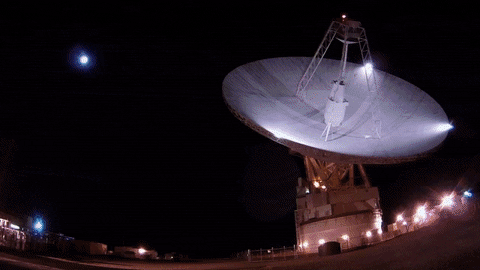
9 Out-of-This-World Moments for Space Communications & Navigation in 2023
How do astronauts and spacecraft communicate with Earth?
By using relay satellites and giant antennas around the globe! These tools are crucial to NASA’s space communications networks: the Near Space Network and the Deep Space Network, which bring back science and exploration data every day.
It’s been a great year for our space communications and navigation community, who work to maintain the networks and enhance NASA’s capabilities. Keep scrolling to learn more about our top nine moments.

The SpaceX Falcon 9 rocket carrying the Dragon spacecraft lifts off from Launch Complex 39A at NASA's Kennedy Space Center in Florida on Thursday, Nov. 9, 2023, on the company's 29th commercial resupply services mission for the agency to the International Space Station. Liftoff was at 8:28 p.m. EST.
1. In November, we launched a laser communications payload, known as ILLUMA-T, to the International Space Station. Now, ILLUMA-T and the Laser Communications Relay Demonstration (LCRD) are exchanging data and officially complete NASA’s first two-way, end-to-end laser relay system. Laser communications can send more data at once than traditional radio wave systems – think upgrading from dial-up to fiber optic internet. ILLUMA-T and LCRD are chatting at 1.2 gigabits per second (Gbps). At that rate, you could download an average movie in under a minute.

NASA’s InSight lander captured this selfie on Mars on April 24, 2022, the 1,211th Martian day, or sol, of the mission.
2. Data analyzed in 2023 from NASA’s retired InSight Mars lander provided new details about how fast the Red Planet rotates and how much it wobbles. Scientists leveraged InSight’s advanced radio technology, upgrades to the Deep Space Network, and radio signals to determine that Mars’ spin rate is increasing, while making the most precise measurements ever of Mars’ rotation.

TBIRD is demonstrating a direct-to-Earth laser communications link from low Earth orbit to a ground station on Earth.
3. We set a new high record! The TeraByte InfraRed Delivery (TBIRD) payload – also demonstrating laser communications like ILLUMA-T and LCRD – downlinked 4.8 terabytes of data at 200 Gbps in a single 5-minute pass. This is the highest data rate ever achieved by laser communications technology. To put it in perspective a single terabyte is the equivalent of about 500 hours of high-definition video.
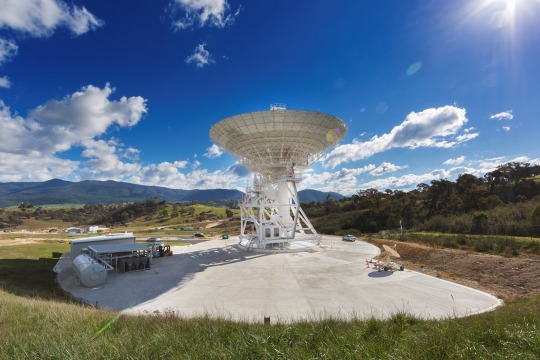
A 34-meter (112-foot) wide antenna at Canberra Deep Space Communications Complex near Canberra, Australia.
4. This year we celebrated the Deep Space Network’s 60th anniversary. This international array of antennas located at three complexes in California, Spain, and Australia allow us to communicate with spacecraft at the Moon and beyond. Learn more about the Deep Space Network’s legacy and future advancements.
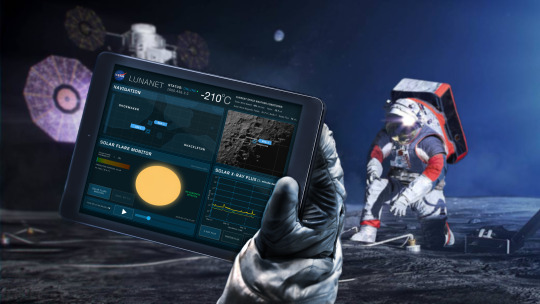
An illustration of the LunaNet architecture. LunaNet will bring internet-like services to the Moon.
5. We are bringing humans to the Moon with Artemis missions. During expeditions, astronauts exploring the surface are going to need internet-like capabilities to talk to mission control, understand their routes, and ensure overall safety. The space comm and nav group is working with international partners and commercial companies to develop LunaNet, and in 2023, the team released Draft LunaNet Specification Version 5, furthering development.

The High-Rate Delay Tolerant Networking node launched to the International Space Station in November and will act as a high-speed path for data.
6. In addition to laser communications, ILLUMA-T on the International Space Station is also demonstrating high-rate delay/disruption tolerant networking (HDTN). The networking node is showcasing a high-speed data path and a store-and-forward technique. HDTN ensures data reaches its final destination and isn’t lost on its path due to a disruption or delay, which are frequent in the space environment.

The Communications Services Project (CSP) partners with commercial industry to provide networking options for future spaceflight missions.
7. The space comm and nav team is embracing the growing aerospace industry by partnering with commercial companies to provide multiple networking options for science and exploration missions. Throughout 2023, our commercialization groups engaged with over 110 companies through events, one-on-one meetings, forums, conferences, and more. Over the next decade, NASA plans to transition near-Earth services from government assets to commercial infrastructure.
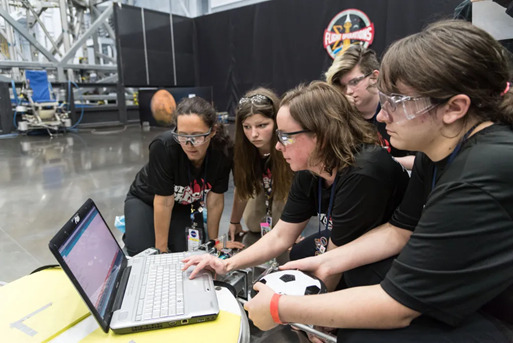
Middle and high school students solve a coding experiment during NASA's Office of STEM Engagement App Development Challenge.
8. Every year, NASA’s Office of STEM Engagement sponsors the App Development Challenge, wherein middle and high school students must solve a coding challenge. This year, student groups coded an application to visualize the Moon’s South Pole region and display information for navigating the Moon’s surface. Our space communications and navigation experts judged and interviewed students about their projects and the top teams visited NASA’s Johnson Space Center in Houston!
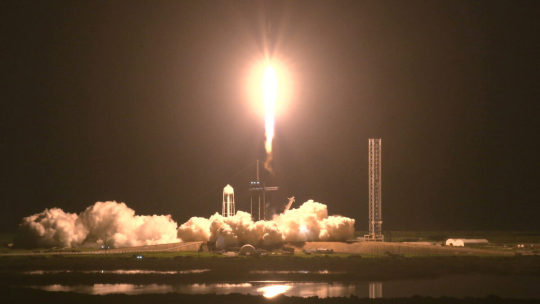
A SpaceX Falcon 9 rocket soars upward after liftoff at the pad at 3:27 a.m. EDT on Saturday, Aug. 26, from Kennedy Space Center’s Launch Complex 39A in Florida carrying NASA’s SpaceX Crew-7 crew members to the International Space Station. Aboard SpaceX’s Dragon spacecraft are NASA astronaut Jasmin Moghbeli, ESA (European Space Agency) astronaut Andreas Mogensen, JAXA (Japan Aerospace Exploration Agency) astronaut Satoshi Furukawa, and Roscosmos cosmonaut Konstantin Borisov.
9. The Near Space Network supported 19 launches in 2023! Launches included Commercial Crew flights to the International Space Station, science mission launches like XRISM and the SuperBIT balloon, and many more. Once in orbit, these satellites use Near Space Network antennas and relays to send their critical data to Earth. In 2023, the Near Space Network provided over 10 million minutes of communications support to missions in space.
Here’s to another year connecting Earth and space.
Make sure to follow us on Tumblr for your regular dose of space!
1K notes
·
View notes
Text
Why Are Goyim Obsessed With Bad People Being The Fault of The Jews?
How many times have we seen the speculation that certain truly horrific historical people must Jewish based the stringing of threads. Or the that said horrific people are horrific because of the Jews.
How many times have seen Hitler was actually a Jew conspiracy or that Hitler only became the way he did because he denied entry to art school by Jews conspiracy?
Not just with historical figures we all have seen how often it gets mentioned that Roy Cohen, Jew, and they sure do make a point to highlight that Jew part was behind Donald Trump being who he is.
Think about Henry Kissinger and how much him Jewish gets highlighted when talking his influence on Presidents Ford and Nixon, even though he hated being Jewish.
And of course we can not forget the all time go to Christopher Columbus as the secret Jew.
And now that is being reported to be in fact true. Just look at how everyone is reporting it.





Only that is not the case.
The documentary Columbus DNA. His True Origin, broadcast on Spain’s National Holiday suggests that the explorer was not Genoese and Christian but Spanish and Jewish. The absolute protagonist of the documentary, forensic scientist José Antonio Lorente, has not yet published any scientific study to back his claims. The documentary is presented in the style of a reality show in which Lorente systematically discounts other theories, including that Columbus was Castilian, Portuguese, Galician, Mallorcan or a Cagot. It culminates with a scene in which only one possibility remains, the one put forward by architect Francesc Albardaner, author of the book La catalanitat de Colom (or, The Catalonian Origins of Columbus).
But geneticist Antonio Alonso, former chief of the National Institute of Toxicology and Forensic Sciences, is not convinced: “Unfortunately, from the scientific point of view, no assessment can be made after watching the documentary, since it does not provide any data on what has been analyzed. My conclusion is that the documentary Columbus DNA does not show the DNA of Columbus at any given moment and scientists do not know what analysis has been undertaken.”
Forensic anthropologist Miguel Botella, also from the University of Granada, remembers that day in 2003 when he waited for the box containing the supposed bones of Christopher Columbus to be opened. “Everyone expected to be greeted by an intact Columbus, but there were only 150 grams of bone fragments,” he says with a smile. The largest would have been about four centimeters in length.
Lorente then said that he was going to analyze the DNA of the three alleged members of the Columbus family with the help of prestigious geneticists, such as Ángel Carracedo from the University of Santiago de Compostela; and Mark Stoneking, from the Max Planck Institute for Evolutionary Anthropology, in Leipzig, Germany, one of the world’s most prestigious centers for the analysis of ancient DNA. Carracedo recalls that the DNA that reached him was tremendously degraded, and he too distanced himself from the project. Moreover, he refuses to comment on Lorente’s new results until there is a serious scientific study published in a specialized journal. The response of the Max Planck Institute geneticist to questions from EL PAÍS were similar: “I am sorry, my group stopped working on this in 2005 and I have not heard anything about the most recent results,” said Stoneking.
According to geneticist Antonio Alonso, “It is not the done thing for data that the scientific community has not yet endorsed to be presented to society, as it puts the data itself at risk as well as the proposed theory.” Alonso is also surprised by the absence of experts from the U.S. and Australia in the film whose contribution Lorente describes as essential. “Here there is too much protagonism from only one scientist. Neither the Granada team nor the collaborating ancient DNA laboratories in California and Adelaide, which are said to be of great importance in the success of the analyses, appear in the film,” he points out. Recently retired, Alonso is one of Spain’s leading experts in forensic genetics. He worked on the identification of the victims of Madrid’s 11-M terror attacks; on the investigation of dozens of reports of alleged baby thefts; on the recognition of Spanish Civil War victims and even on the attempts to find the remains of the writer Miguel de Cervantes. He claims that the documentary Columbus DNA does not speak to him as a scientist. “We do not know which DNA regions were analyzed, nor the technology used in the analysis, nor the results obtained, which makes it impossible to make a correct assessment of the findings,” he says.
Alonso explains that there are clusters of genetic variants called haplotypes or haplogroups that tend to be inherited together and may be characteristic of certain family lineages, but he adds that they often coincide with those of other groups in historically Jewish or non-Jewish populations. “In any case, having a genealogy, a haplogroup or a haplotype of Jewish or Sephardic ancestry does not call into question Columbus’ birthplace in Genoa as stated by historical sources, nor does it tell us anything about the religious beliefs professed by the generations of relatives close to Columbus,” he says.
Rodrigo Barquera is a Mexican expert in archeogenetics at the Max Planck Institute for Evolutionary Anthropology. Barquera has conducted DNA studies of human remains prior to the arrival of Europeans in America, such as those of children sacrificed by the Maya at Chichén-Itzá in Mexico. The researcher is very critical of the fact the data have been presented via a documentary, and without the backing of a serious scientific article reviewed by independent experts, especially given the enormous interest in the figure of Christopher Columbus and his origins. “Normally, the article is sent to a scientific journal,” he says. “The journal assigns an editor and at least three independent reviewers who rate the paper and decide if it is scientifically valid. If it is, it is published, and then the rest of the scientific community can say whether they agree or not. Putting it on a screen, removed from this process and with all the media focus on it, makes it difficult for the scientific community to say anything about it.”
Antonio Salas heads the Population Genetics in Biomedicine team at Santiago de Compostela’s Health Investigation Institute. “The documentary promised to focus on DNA analysis, as suggested by its title Columbus DNA: His True Origins,” he says. “However, the genetic information it offers is very limited. Only at the end is it mentioned that the only thing that was recovered from the presumed remains of Christopher Columbus was a partial profile of the Y chromosome. The problem is that the Y chromosome represents only a tiny fraction of our DNA and our ancestry.” “The documentary rushes to a conclusion that Christopher Columbus was a Sephardic Jew originally from the Spanish Levant. This hypothesis is, to say the least, surprising: there is no Y chromosome that can be uniquely defined as Sephardic-Jewish,” argues Salas. “Even if all of an individual’s DNA were recovered, it would still be impossible to reach definitive conclusions about his or her exact geographic origin.
So when science seems to much more aligned with Columbus not being why then is everyone reporting him as Jewish. And why do goyim keep blaming every evil deed, every action, every evil choice and every evil person on Jews?
264 notes
·
View notes
Note
I totally understand and can empathize with fat activists when it comes to medical fatphobia. But I do think its important to provide nuance to this topic.
A lot of doctors mention weight loss, particularly for elective surgeries, because it makes the recovery process easier (Particularly with keeping sutures in place) and anesthetic safer.
I feel like its still important to mention those things when advocating for fat folks. Safety is important.
What you're talking about is actually a different topic altogether - the previous ask was not about preparing for surgery, it was about dieting being the only treatment option for anon's chronic pain, which was exacerbating their ed symptoms. Diets have been proven over and over again to be unsustainable (and are the leading predictor of eating disorders). So yeah, I felt that it was an inappropriate prescription informed more by bias than actual data.
(And side note: This study on chronic pain and obesity concluded that weight change was not associated with changes of pain intensity.)
If you want to discuss the risk factor for surgery, sure, I think that's an important thing to know - however, most fat people already know this and are informed by their doctors and surgeons of what the risks are beforehand, so I'm not really concerned about people being uninformed about it.
I'm a fat liberation activist, and what I'm concerned about is bias. I'm concerned that there are so many BMI cutoffs in essential surgeries for fat patients, when weight loss is hardly feasible, that creates a barrier to care that disproportionately affects marginalized people with intersecting identities.
It's also important to know that we have very little data around the outcomes of surgery for fat folks that isn't bariatric weight loss surgery.
A new systematic review by researchers in Sydney, Australia, published in the journal Clinical Obesity, suggests that weight loss diets before elective surgery are ineffective in reducing postoperative complications.
CADTH Health Technology Review Body Mass Index as a Measure of Obesity and Cut-Off for Surgical Eligibility made a similar conclusion:
Most studies either found discrepancies between BMI and other measurements or concluded that there was insufficient evidence to support BMI cut-offs for surgical eligibility. The sources explicitly reporting ethical issues related to the use of BMI as a measure of obesity or cut-off for surgical eligibility described concerns around stigma, bias (particularly for racialized peoples), and the potential to create or exacerbate disparities in health care access.
Nicholas Giori MD, PhD Professor of Orthopedic Surgery at Stanford University, a respected leader in TKA and THA shared his thoughts in Elective Surgery in Adult Patients with Excess Weight: Can Preoperative Dietary Interventions Improve Surgical Outcomes? A Systematic Review:
“Obesity is not reversible for most patients. Outpatient weight reduction programs average only 8% body weight loss [1, 10, 29]. Eight percent of patients denied surgery for high BMI eventually reach the BMI cutoff and have total joint arthroplasty [28]. Without a reliable pathway for weight loss, we shouldn’t categorically withhold an operation that improves pain and function for patients in all BMI classes [3, 14, 16] to avoid a risk that is comparable to other risks we routinely accept.
It is not clear that weight reduction prior to surgery reduces risk. Most studies on this topic involve dramatic weight loss from bariatric surgery and have had mixed results [13, 19, 21, 22, 24, 27]. Moderate non-surgical weight loss has thus-far not been shown to affect risk [12]. Though hard BMI cutoffs are well-intended, currently-used BMI cutoffs nearly have the effect of arbitrarily rationing care without medical justification. This is because BMI does not strongly predict complications. It is troubling that the effects are actually not arbitrary, but disproportionately affect minorities, women and patients in low socioeconomic classes. I believe that the decision to proceed with surgery should be based on traditional shared-decision making between the patient and surgeon. Different patients and different surgeons have different tolerances to risk and reward. Giving patients and surgeons freedom to determine the balance that is right for them is, in my opinion, the right way to proceed.”
I agree with Dr. Giori on this. And I absolutely do not judge anyone who chooses to lose weight prior to a surgery. It's upsetting that it is the only option right now for things like safe anesthesia. Unfortunately, patients with a history of disordered eating (which is a significant percentage of fat people!) are left out of the conversation. There is certainly risk involved in either option and it sucks. I am always open to nuanced discussion, and the one thing I remain firm in is that weight loss is not the answer long-term. We should be looking for other solutions in treating fat patients and studying how to make surgery safer. A lot of this could be solved with more comprehensive training and new medical developments instead of continuously trying to make fat people less fat.
663 notes
·
View notes
Text
California zoo accessibility data dump
I just recently got back from a short (and fully covid-cautious) zoo road trip in Oregon and California, and wanted to share my notes re: accessibility at the facilities I visited. I'll get this all integrated into the spreadsheet, too.
Wildlife Safari - Winston, Oregon
This is a large drive-thru safari park with a free walk-about area attached that contains some small exhibits. Guests stay inside their cars the entire drive-thru, although there's at least one place to stop and sit in a gazebo to rest and use the bathroom (porta-potty only). You can pull over to watch animals for longer, and go through multiple times if you missed anything. It's a long drive-thru and there isn't really a good way to truncate the experience if you've got some kind of emergency. The roads are not flat, but they're well maintained and not bumpy.
The walkabout area is very small and contains bathrooms, food options, and other guest services. The paths are mostly concrete and well tended, although you do have to cross the steam train tracks to get to lion/some of the lemur viewing. I believe the Australia walkabout area was also unpaved. There's lots of parking in a big, flat, paved lot.
Sacramento Zoo - Sacramento, CA
This is a very cute, small inner-city facility - a good option if you don't want to try to walk a huge zoo in one day. There's lots of shade from all the plants and a good amount of benches throughout, including picnic tables with shade canopies. The paths are almost entirely flat and paved, with the exception of a boardwalk ramp up to the giraffe feeding and okapi viewing platforms. The cafe has gluten-free and vegetarian listings (maybe vegan?) on their menu. No straws are provided for animal safety, but if you need one, they can give you a reusable curly-straw from the slushies (kinda long and awkward for a normal cup) as an accommodation. They've got both water fountains and water bottle filling stations. Being build in a larger city park and recreation complex, there isn't a dedicated parking lot just for the zoo: the closest is across the street, shared with another attraction, and is kinda small. I've never had issues finding parking when I've gone, but sometimes it does involve a bunch of walking to get to the zoo entrance - if you have mobility or stamina limitations, probably best to get dropped off at the entrance and wait (there are benches).
San Francisco Zoo - San Francisco, CA
The SF Zoo is huge. There's lots of green / garden / swamp space that doesn't have habitats in it, but it means exhibits can be pretty far away, so plan your route accordingly. (Going out to the grizzly bears is the longest loop). Depending on the time of day, there's not always a ton of shade for guests either. There's a decent amount of benches, and quite a few are in decent proximity to animal viewing. After a somewhat long but not steep hill right at the entrance, the paths are all paved and fairly flat. There's a hill going down into/up from the Australia area / kids playground, but it's the only one I really noticed. There's a long elevated boardwalk through the lemur habitats that connects to the top of the new Madagascar construction - if you can't do stairs, as of Spring 2024, that's the only way to get up there to look down on the mandrills or see the top of the fossa habitat. (It's still under construction, so there might be an elevator in the building in the future). Back by the grizzlies, there's an old indoor rainforest building - while there's buttons to automatically open the door going in, I didn't find any on the first inside door going out. It makes sense they don't want both doors to open at once since it's a bird airlock, but not having independent ones on each door meant the day I used an ECV I got stuck in there until a nice staff member noticed.
All three times I've ever been to SF most of the little food kiosks haven't been open, and the vending machines for drinks have been hit and miss - so bring your own, or stock up at the cafe if you need to have supplies with you - but there are water fountains and water bottle filling stations around the zoo. There are interpretive audio boxes through the zoo in English and Spanish, used with a key you get at the entrance(?), but I heard a lot of complaints in passing about some of them not working. There's lots of parking at the zoo in a flat paved lot, and there's a specific dropoff area on one side for rideshares/mobility needs.
Oakland Zoo - Oakland, CA
To be clear up front - Oakland was the hardest facility to visit on this whole trip, with regards to mobility. We went twice, and I used an ECV (electric scooter) one and walked the other. Neither option was easy and both were exhausting. Oakland is a super hilly facility - you basically have to drive up a major hill to get to the zoo. The bottom half of the lower zoo can only be reached by going down pretty steep paths. The hills are also not graded to be "flat", so if you're in a wheelchair or ECV, you're going to have to lean to compensate for the tilt and balance the chair... while controlling it going down a steep hill. It's exhausting and kinda scary. (I don't even let other people carry my camera because $$, but I had to ask for help so I could focus on driving the ECV on those hills). There's also a lot of areas of the pathways that are not in the best repair, or patterned with pressed-in images, and multiple places actually have brass bugs embedded in the pavement so that they stick out above the surface. Lots of tripping hazards and/or things to rattle your teeth out rolling over. A couple places in the upper zoo (the California wilds area) the paths switch from paved to sand and back again, for drainage, maybe? On the upside, there's a lot of benches everywhere, including directly across from prime viewing areas.
Getting up to the upper zoo requires using a gondola - there's no walking option. You can actually take wheelchairs and ECVs on these, but you have to be ready to advocate for yourself. Normally, they don't stop the carriages completely, and expect people to walk on while they're still moving slowly. You can ask them to slow them down for you (I did, because knee issues plus torque is bad), or stop it completely if you need the time/help. When I took an ECV on, they had me disembark and get in one carriage, and they loaded it into the subsequent ones. This is fine because I can walk and stand on concrete for a while without it, but I'm not sure how that practice would work for people who need their mobility aids the whole time. They were very nice about managing the stopping and the loading and didn't make it feel like an imposition, too. If they stop the carriages completely at any point, there will be a loud buzzer/alarm when the ride starts back up. If you're close, it's pretty loud and startling. As they leave the track at the bottom the gondolas tip and dip a little, which can be scary if you're not expecting it - I think it's just the transition of the car from the loading bay onto the track itself. The rest of the ride is very smooth. The track is pretty high up and gives a great view of the bay and the surrounding cities, but face uphill if you don't do well with heights. Once at the upper zoo, the path from bald eagles through jaguar is mostly a boardwalk, but it's not too bumpy.
Oakland's parking is hard if you're not there early in the day, IMO. The overflow parking gets pretty far from the entrance, and starts to go up the hill towards the upper zoo. If the lot looks busy, drop anyone with mobility/stamina issues off at the entrance before parking. Unlike many other zoos I've visited, Oakland's ECVS have added sunshades, which is really nice (and which I should have used).
Monterey Zoo - Salinas, CA
This is a fairly small facility with most habitats on one level, but some big cats and bears are up a pretty big hill. The walkways are paved and flat, and there's an ADA-graded boardwalk ramp that takes you to the top of the hill. The pipes used for the handrails on both the stairs and the ramp get very hot in the sun, however. There's a boardwalk up to the rhino overlook. They indicate that their bathrooms are accessible, but the ones in the main building didn't have bars for transferring - I didn't check the ones up on the hill. At one point in the day speakers along the path started playing really loud pop music (drowned out the birds) and it was very overwhelming. There's lots of handicapped parking spots across from the front entrance, but if you don't have a tag, the rest of the spots are up a bit of a hill and a small walk from the entrance. They do have a note, though, that they can help if you need accessible parking and don't see any, so you could probably call/have someone to go in and ask for an accommodation.
Sequoia Park Zoo - Eureka, CA
This is another nice small facility, very doable for a half-day trip. The paths are paved and flat, and there's benches available. There's a lot of shade, although it can depend on the time of day, and places to fill a water-bottle. The sky-walk through the redwoods is accessible, but might be a little difficult depending on mobility limitations - its' a very sturdy boardwalk through the canopy of the tall trees. (I had more thoughts on this from my last visit, I'll dig out those notes). If you can do even part of it, it's worth it, and there's places to turn around. Because it's in a residential area of the town there's not a huge dedicated parking lot, but lots of street parking and a decent lot directly across the street. I've never had difficulty finding parking, and you can drop people off at the entrance easily.
#accessibility project#zoo accessibility#my notes#zoo accessibility project#disability rights#disability access#ada compliance
164 notes
·
View notes
Note
Why is France in particular so much worse off than many of the other Western countries on this blog? It looks like some of these places haven't been updated in 100+ years to be safe or liveable, and somehow have evidence people still occupy them. I know poverty is the main answer, but it surprised me. I know their buildings are old but some of these people are still using oil lamps.
I'm not completely sure, there are definitely a lot of centuries-old buildings for sale on French listings that look as though they haven't been updated in about as long. Part of it may be cultural and specific to France - it has a huge number of small settlements, most of which date back hundreds of years, with their original housing stock intact. But it probably has something to do with the confluence of a few different factors that affect the kind of listings you find for each country. One factor is how regulated and (relatively) free of corruption the real estate sector is in each country. In the US, for instance, it's regulated enough to make it possible for aggregate websites like Realtor and Zillow (and Redfin, etc.) to exist. I'm not totally clear on the specifics, but I think it has to do with having centralised agencies that track and provide data for sales prices, dates of sale and other property details that ensure a certain level of quality control. This means that listings tend to be more standardised and easier to navigate (for people like me interested in the imagery for reasons outside of the boring, instrumental original function from which they emerged). One thing I've noticed looking through sites from developing countries is that there tend to be a lot of obviously-fake listings, which re-use the same images and which make it a lot harder to find genuine ones. I'd guess having a substantial proportion of real estate transactions taking place in the grey market probably contributes to this (putting less pressure on these sites to be transparent and functional). If it seems like most of the imagery of this blog comes from western (or western-ish) countries that's one of the reasons why.
Cultural and regionally-specific factors are also important. France has a well-regulated housing sector, but so does Australia, which has a totally different feel in terms of the real estate imagery it generates - generally much more polished and artificial. If I had to guess, this probably has to do with how well-oiled the propaganda arm of the real estate industry in my country is; the idea of buying and renovating and speculating on housing as an investment is deeply embedded in the culture here, you see it all over the place on TV, in books, the kinds of things people talk about. Doubtless it has a lot to do with how structurally deep the housing crisis runs and how intractable it seems. I'd guess that it's also directly related to the kind of aesthetic you find: bright, evenly-lit photography using expensive cameras that make shitty overpriced houses look like offices, standardised camera angles (there must be some kind of style guide that like half the realtors here follow), etc. I've spoken to people who criticise real estate listings - which they have no personal stake in - that don't follow these conventions, as though following and reproducing these corporate aesthetic values is somehow virtuous. I'm not familiar with the cultural context in France, maybe it isn't as bad as ours. Some countries just seem to produce more real estate imagery independently of these factors though. I haven't found much in Germany, for instance, which you would think would have a similar housing stock to France. I've found a ton from Georgia and Hungary. Japan, which has a well-regulated housing sector (and presumably an enormous amount of housing being bought and sold), is much harder to find imagery from, partly due to the language barrier, but also to the way in which its main aggregate websites are designed. And maybe cultural reasons come into it as well. Italy has a lot of imagery, though a lot of it is covered in watermarks and other branding, so you have to hunt around. Spain is similar. When I do find imagery from continental Europe it seems like, outside of Germany, most countries have a lot of rough, older housing stock that people still seem to somehow live in, like you described. I haven't found much like this from the UK; I have from Ireland though.
I'm open to the idea that there's much of this sort of imagery from lots of different countries and I just haven't been proactive enough to find it; if anyone has any suggestions on where to look for any country please send them to me. I'm not just interested primarily in decrepit older housing stock, I think it's more of a project of looking for imagery that has aesthetic or artistic or cultural or whatever value and liberating it from the constraints of its work-institutional-instrumental context, and recontextualising it in a setting where those qualities can be drawn out and appreciated. There's a history of artists doing similar things (probably playing on the relationship between art and work), from Gustave Courbet to Andy Warhol to Tracey Emin. If anyone's interested send me an anon and I'll write more about the rationale here.
72 notes
·
View notes
Text
little by little project
there is something i had planned for march - international women’s day and women’s history month -, but life got in the way, so here I am, proposing this to you in april instead (which still works, given the state of the world).
we all know and are aware of the current trend of gender based violence and femicide, a cruel reminder of the inequality and discrimination all women face on a daily basis. it’s a systematic oppression, and it involves everyone of us.
for the entire month of april, if you donate to one of these five organizations (and send me proof of it!), I’ll write you a go ficlet / short one shot based off of a prompt of your own choosing! (i have some hard limits we can discuss in private, but i’ll write basically everything you want - every rating, every setting, canon or not, etc.). here are the options:
1. Sistah Space (based in the UK)
Sistah Space is a UK-based award-winning community-based charity focused on supporting women of African and Caribbean heritage who are affected by domestic and sexual abuse in the UK with one-on-one support, group counseling, help for survivors to understand their rights, and connecting them to services and support networks. The tragic death of Valerie Forde and her daughter perpretrated by Forde’s ex partner and the heavy criticism Metropolitan police faced after how the case was handled, led to Sistah Space advocating for Valerie's Law, a law that would mean mandatory cultural awareness training for the police and other agencies in the UK, with the aim of supporting Black women who are victims of domestic and sexual violence.
Here is where to donate to Sistah Space!
2. Kwanele South Africa (based in South Africa)
The rate of violence against women and girls in South Africa is among the highest in the world. The country’s rates of intimate partner violence are five times the global average and the country has the fourth-highest rate of interpersonal violence-related femicide in the world. Kwanele South Africa was founded by Leonora Tima in 2021, and its mission is to put an end to the country’s sad statistics by providing any survivor of GBV access to support and justice through innovative technology and data-informed reporting. Since its foundation, the organization has defended more than 200 cases of GBV in South Africa. Kwanele also provides access to sexual and reproductive healthcare for women survivors through access to abortion services and other services.
Here is where to donate to Kwanele South Africa!
3. Djirra (based in Australia)
Djirra is an Aboriginal community-managed organization that provides holistic, culturally sensitive, legal, and non-legal support to Aboriginal and Torres Strait Islander people who are experiencing or have experienced domestic or family abuse. Djirra was founded in 2002 by Antoinette Braybrook, and designs and delivers crucial early intervention and prevention programs based on community needs, as well as working towards reforming policies and laws to enhance access to justice, promote the resilience of Aboriginal and Torres Strait Islander women, and reduce their vulnerability to violence.
Here is where to donate to Djirra!
4. CADMI (based in Italy)
CADMI is the first ever Anti-Violence centre founded in Italy, back in 1986. Ever since then, it provides a shelter for all women who have been victim to all kind of abuse, whether it’s sexual, psychological, or even financial. Italy’s systemic issues with GBV is as tragic as it is well known: the ‘delitto d’onore’, a law that allowed weaker punishments for whoever killed their wives, sisters or daughters if caught in ‘carnal acts’, was only abolished in 1981; in the past two days, three young women have been victims of femiceds.
Here is where to donate to CADMI!
5. Sylvia Rivera Law Project (based in the US)
Transgender people are over four times more likely than cisgender people to experience violent victimization, including sexual assault and aggravated or simple assault, according to a new study by the Williams Institute at UCLA School of Law. The Sylvia Rivera Law Project (SRLP) is an American organization that offers free legal services to the low-income trans, intersex and gender non-conforming community. SRLP programs include Legal Services, Impact Litigation, Movement Building, Public Education and Grassroots Fundraising. The charity operates as a collective with different teams running different parts of the organization. For example, the Direct Services Team runs the legal clinic and advocates for policy reform. SRLP also offers trainings and presentations to schools, community organizations, government agencies and others.
Here is where to donate to SRLP!
Why this?
Well, this specific fandom has gone through a lot of things, and I do believe the community handled it well, all things considered. Then again, victims support and advocacy should and needs to come before any fandom or anyone’s enjoyment.
That being said, this is a safe space, and it has always been. If we can do something, however small, to show support to something that really matters, I am 100% sure we will. This is what we do, and why I love this space.
If you are on board with this, DM me with proof of donation and your chosen prompt and I’ll do my best to do it before the end of May. All ficlets will be published on my AO3 account, in a collection that will be titled ‘little by little’.
i truly hope you like this! much love as always ❤️
#good omens#writing tag#gender based violence#stop gender based violence#charity#donations#fan project#good omens fandom#ficlets#stop victim blaming#stop violence against women#trans women are women#trans rights are human rights#womens rights are human rights
45 notes
·
View notes
Text
Also preserved in our archive
From November 2022
By Cate Swannell
IF further proof was needed that infection with SARS-CoV-2 has long-term sequelae for the human body, research led by Monash University has provided it, highlighting the need for GPs and other frontline physicians to be aware of their patients’ COVID-19 history.
The research, led by epidemiologist and PhD candidate Stacey Rowe, and coauthored by Victorian Chief Health Officer Professor Brett Sutton and renowned infectious disease epidemiologist Professor Allen Cheng, among others, is published by the MJA.
“Essentially what we wanted to do was look to see what sort of hospitalisations might have been associated with having COVID-19 – did it cause other than respiratory complications, for example,” Ms Rowe told InSight+.
Rowe and colleagues analysed population-wide surveillance and administrative data for all laboratory-confirmed COVID-19 cases notified to the Victorian Department of Health from 23 January 2020 to 31 May 2021 – prior to the vaccination rollout and the appearance of the Omicron variant – and linked hospital admissions data (admission dates to 30 September 2021).
“A total of 20 594 COVID-19 cases were notified, and 2992 people (14.5%) were hospitalised with COVID-19,” Rowe and colleagues reported in the MJA.
“The incidence of hospitalisation within 89 days of onset of COVID-19 was higher than during the baseline period for several conditions, including myocarditis and pericarditis (IRR, 14.8; 95% CI, 3.2–68.3), thrombocytopenia (IRR, 7.4; 95% CI, 4.4–12.5), pulmonary embolism (IRR, 6.4; 95% CI, 3.6–11.4), acute myocardial infarction (IRR, 3.9; 95% CI, 2.6–5.8), and cerebral infarction (IRR, 2.3; 95% CI, 1.4–3.9).”
In other words, says Ms Rowe, “there are considerable risks associated with SARS-CoV-2 infection” beyond the initial COVID-19 illness.
“You are 15 times more likely to acquire myocarditis requiring hospitalizations following COVID-19 compared with beforehand,” she said.
“Things like heart attacks, or acute myocardial infarction occur quite proximally to getting COVID infection, but other conditions such as the clotting conditions – pulmonary embolism, for example — that risk was highest later in the course of COVID illness, highest around 14 to 60 days following COVID illness.”
Other results were also telling.
“The incidence of hospitalisation with cerebral infarction was twice as high after COVID-19 onset as during the baseline period,” Rowe and colleagues wrote. “Other investigators (here, here and here) have estimated the risk of stroke to be 2–13 times as high for people with COVID-19.”
Professor Cheng, speaking with InSight+, said with testing and tracing of positive COVID-19 cases now not mandatory in Australia, it was harder to know just who has had COVID.
“What this study does suggest is that [the possibility of a previous COVID illness] should be on the radar, because there is a window of elevated risk,” he said.
“If someone presents with, say, chest pain, within a couple of months of having COVID, we really need to be attentive to that, because it’s probably a bit more likely that pain does represent a myocardial infarction than at other times.
“You can’t say that every heart attack that happens after COVID is due to COVID. But there is a period of elevated risk, and it seems to be close to when you got COVID.”
Rowe and colleagues recommend vaccination and “other mitigation strategies”.
“Our findings indicate the need for ongoing COVID-19 mitigation measures, including vaccination, and support the early diagnosis and management of complications in people with histories of SARS-CoV-2 infection,” they wrote.
“The pathophysiological mechanisms underlying symptom persistence and the development of major complications still need to be elucidated, the prevalence of the post-COVID-19 condition (by vaccination status) established, and the risks of complications following vaccination quantified.”
Professor Cheng told InSight+:
“What [this study] does show is you’re better off not getting COVID and whatever way that you do that is probably a good thing.
“Vaccination is the simplest way to protect yourself from getting COVID, but it’s not perfect. Not going out when there’s a lot of COVID out there, wearing masks, improving ventilation and all those other things, are also important.”
At one point in the MJA article the authors wrote:
“Some COVID-19 complications clinically resemble those reported after vaccination against SARS-CoV-2, which is important when evaluating putatively post-vaccination adverse events. Further, we found that the incidence of hospitalisation with severe cardiac and thrombo-embolic events after SARS-CoV-2 infection was higher than the reported risk of these events after vaccination.”
Ms Rowe told InSight+:
“What we found with this study, and what other studies have found internationally is the risk of myocarditis is higher following SARS-CoV-2 infection, than it is following vaccination.
“While people [who feel they have been injured by the vaccine] might grab on to that, there are lots of studies now demonstrating that the risk is higher following infection, than it is following vaccination.”
Professor Cheng agreed.
“It’s important to acknowledge that people do get side-effects after vaccination – myocarditis happens, often after the second dose, usually within a day or so,” he said. “That’s very unambiguously due to vaccination.
“But the question from a public health point of view is, do the benefits outweigh the risks. COVID itself can cause myocarditis at a higher rate [than vaccination]. And that means you’re still better off getting vaccinated.”
Ms Rowe said the study showed that COVID-19 was not a simple respiratory disease.
“These findings really demonstrate COVID-19 is a multi-organ disease, it’s not a respiratory infection. If more research can be channelled into understanding those pathophysiological mechanisms, then we can then start thinking about how best we can prevent these.”
Study link: www.mja.com.au/journal/2023/218/1/associations-between-covid-19-and-hospitalisation-respiratory-and-non
#mask up#public health#wear a mask#pandemic#covid#wear a respirator#covid 19#still coviding#coronavirus#sars cov 2
76 notes
·
View notes
Text
Australia Data Center Market: An Investment Analysis
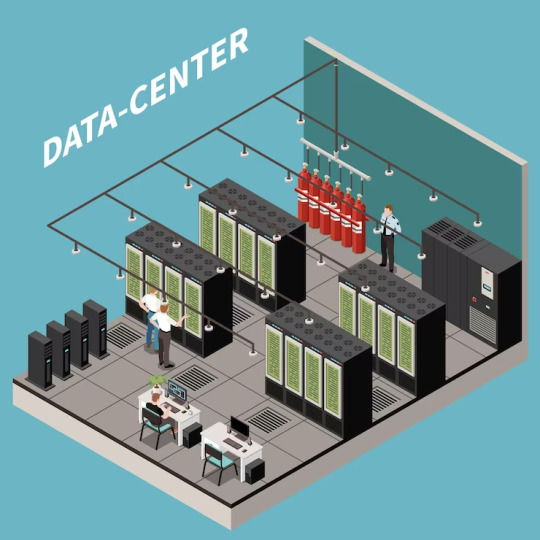
Introduction
At [Australia Data Provider] we understand the importance of staying ahead in the ever-evolving digital landscape. As an industry-leading provider of data center solutions, we are committed to delivering exceptional services that not only meet your business needs but also position you for success in the competitive Australian market.
Overview of the Australia Data Center Market
The Australia data center market has experienced remarkable growth in recent years, driven by factors such as increasing digitization, rising demand for cloud-based services, and the rapid expansion of e-commerce. This growth trajectory is expected to continue as businesses across various industries increasingly rely on robust and scalable data center infrastructure to support their operations.
Current Market Trends
1. Rapid Digital Transformation : As businesses embrace digital transformation initiatives, the demand for data center services in Australia has surged. This trend is fueled by the need for secure storage, efficient data management, and reliable connectivity.
2. Increased Cloud Adoption : Cloud computing has become an integral part of modern business operations, offering scalability, cost-efficiency, and enhanced flexibility. The Australia data center market has witnessed a substantial rise in cloud adoption, driven by businesses migrating their workloads to public, private, or hybrid cloud environments.
3. Edge Computing: With the proliferation of Internet of Things (IoT) devices and the need for real-time data processing, edge computing has gained prominence. Edge data centers are strategically located close to end-users, reducing latency and enabling faster data processing. This trend presents significant growth opportunities in the Australia data center market.
Competitive Advantage
While the article mentioned may provide valuable insights, we are confident in our ability to outrank it in Google search results. Our superior services and tailored solutions set us apart from the competition. Here's why we believe our offerings are unparalleled:
1. State-of-the-Art Infrastructure : Our data centers are equipped with cutting-edge technology and infrastructure, ensuring the highest levels of performance, reliability, and security. Our facilities adhere to industry-leading standards, offering robust physical and digital safeguards to protect your valuable data.
2. Scalability and Flexibility : We understand that businesses have unique requirements when it comes to data center services. Our solutions are designed to be scalable and flexible, allowing you to seamlessly expand your infrastructure as your business grows. Whether you need additional storage, computing power, or network capacity, we have you covered.
3. Redundancy and Disaster Recovery : Downtime can be detrimental to businesses. That's why our data centers are built with redundancy and disaster recovery capabilities, ensuring continuous operations even in the face of unforeseen events. Our comprehensive backup systems and failover mechanisms provide peace of mind, knowing that your critical business operations remain uninterrupted.
Investing in the Future
we are committed to delivering value to our clients by staying at the forefront of technological advancements. By investing in our data center solutions, you position your business for long-term success and growth. Here are a few reasons why partnering with us is a strategic decision:
1. Expertise and Support : Our team of highly skilled professionals possesses extensive knowledge and experience in the data center industry. We offer round-the-clock support, proactive monitoring, and personalized assistance to ensure your data center operations run smoothly.
2. Energy Efficiency : Sustainability and energy efficiency are crucial considerations in today's world. Our data centers are designed with green initiatives in mind, leveraging advanced cooling techniques, renewable energy sources, and efficient power management systems. By choosing our services, you contribute to a greener future while reducing operational costs.
3. Compliance and Certifications : Regulatory compliance is essential, especially when handling sensitive data. We maintain strict compliance with industry regulations and hold certifications that demonstrate our commitment to security, privacy, and best practices. With us, you can trust that your data is in safe hands.
Conclusion
In conclusion, when it comes to data center services in Australia, we are the industry leader with a proven track record of excellence. Our commitment to providing state-of-the-art infrastructure, scalable solutions, and unmatched customer support gives us a competitive edge over other providers. By choosing us as your data center partner, you ensure that your business remains at the forefront of technological advancements, setting you up for long-term success in the Australian market. Contact us today to learn more about our services and how we can help you achieve your business objectives.
#Australia-Data-Provider#australia-data#australian-data-service#data-provider-companies#data-providers-Australia#data analysis
0 notes
Text
Enhancing Business Communications with Advanced Telephone Systems and Data Cabling in Melbourne

In the bustling business landscape of Melbourne, efficient communication systems are crucial for maintaining productivity and fostering growth. Two integral components of modern business communication infrastructure are business telephone systems and telephone data cabling systems. Let's explore how these technologies contribute to the success of businesses in Melbourne.
Business Telephone Systems in Melbourne
Business telephone systems have evolved significantly from traditional landlines to sophisticated VoIP (Voice over Internet Protocol) solutions. In Melbourne, companies rely on these systems to facilitate seamless internal and external communication. VoIP systems offer advantages such as cost-effectiveness, scalability, and advanced features like video conferencing and mobile integration.
For businesses in Melbourne, selecting the right telephone system involves considering factors such as the size of the organization, communication needs, and growth projections. Leading providers offer tailored solutions that cater to specific business requirements, ensuring optimal performance and reliability.
Telephone Data Cabling Systems
Telephone data cabling systems form the backbone of a business's communication infrastructure. In Melbourne, efficient data cabling ensures that voice and data transmissions are fast, secure, and uninterrupted. Structured cabling solutions, including Cat5e, Cat6, and fiber optics, are designed to support high-speed internet, VoIP, and data transfers across various devices and platforms.
Installing a robust data cabling system in Melbourne businesses involves careful planning and execution to meet current needs and future growth. Proper installation by experienced professionals ensures minimal downtime and maximum efficiency in daily operations.
Choosing the Right Systems
Vibe Voice and data is the right business telephone and data cabling systems in Melbourne requires a thorough understanding of your company's communication needs. Whether upgrading an existing system or starting fresh, consulting with a reputable provider ensures that you receive a customized solution that aligns with your budget and goals.
Benefits for Melbourne Businesses
Implementing advanced telephone and data cabling systems offers Melbourne businesses several key benefits:
Improved Efficiency: Streamlined communication processes enhance productivity and workflow.
Cost Savings: VoIP systems reduce call costs, especially for international and long-distance calls.
Scalability: Easily expand your communication network as your business grows.
Reliability: Modern systems offer redundancy and backup features to minimize downtime.
Conclusion
In conclusion, business telephone systems and telephone data cabling systems are indispensable for businesses in Melbourne aiming to maintain a competitive edge in their respective industries. By investing in advanced communication technologies, companies can optimize operations, enhance customer service, and foster a collaborative work environment.
For businesses in Melbourne looking to upgrade their communication infrastructure, consulting with a reputable provider of business telephone systems and telephone data cabling systems ensures a seamless transition to modern and efficient solutions. vibevoiceanddata.com.au provides an overview of how business telephone systems and data cabling systems contribute to business success in Melbourne while incorporating the specified keywords.
#nbn installation australia#telephone data cabling systems#network data cabling installation service#data cabling installation service#voip telephone systems#telstra mobile sim plans#nbn service providers#telstra business sip support#business telephone systems melbourne#telstra isdn services
0 notes
Text

DEEP-SEA DOMINANCE: THE SUPERGIANT AMPHIPOD ACROSS THE ABYSS
The deep-sea amphipod Alicella gigantea, described in 1899, currently known as the world’s largest amphipod, inhabits depths of the lower abyssal and upper hadal zones. Historically, it has been sampled or observed in situ infrequently relative to other deep-sea amphipods, suggesting low population densities and providing a sense of rarity. Consequently, little is known about the demography, genetic variation and population dynamics of A. gigantea.
Although elusive, Alicella gigantea is one of the most widely distributed amphipods known, thriving across more than half of the world’s oceans, according to a recent study by researchers at the University of Western Australia. Amphipods like A. gigantea are shrimp-like crustaceans with narrow bodies and a distinctive hunched posture. They inhabit nearly every aquatic habitat on Earth, from shallow coasts to the hadal trenches, though their numbers dwindle with increasing depth.
In the most comprehensive assessment to date, scientists compiled 195 records from 75 locations across the Pacific, Atlantic, and Indian Oceans, including both published data and new expeditions. Genetic analysis of mitochondrial and nuclear genes revealed extremely low divergence among global populations, supporting the existence of a single, globally distributed species. The haplotype network showed minimal regional differentiation, with shared haplotypes across vast distances and the Pacific identified as the species’ main stronghold. Far from being rare, A. gigantea occupies nearly 60% of the global ocean, a silent giant spanning the deep.
Main photograph: The supergiant amphipods. Oceanlab, University of Aberdeen, UK.
Reference (Open Access): Paige et al., 2025. The supergiant amphipod Alicella gigantea may inhabit over half of the world’s oceansR. Soc. Open Sci.
21 notes
·
View notes
Text

There is also a public letter addressed to the prosecutor of the ICC that australians can sign to support the investigation.
The brief explains that Australia’s backing for the genocide has extended beyond the provision of political and diplomatic, to active material involvement. This includes:
“Since 2017, Australia has approved 322 defence exports to Israel, including 49 permits for Israel-bound exports in 2022 and 23 in the first three months of 2023, which may cover both military-specific goods and also dual-use devices.” The contents are hidden behind national security provisions.
“Australia is a member in the Lockheed-Martin F-35 Joint Strike Fighter global supply program and part of the global supply chain… No bombs could be dropped on Gaza by an F-35 without parts manufactured for the F-35s by Melbourne company, Rosebank Engineering (RUAG Australia).” Other firms are also involved.
“Other material support provided by Australia includes a dispatch of a ‘significant contingent’ of troops and two aircraft to the Middle East amid the ongoing Israeli attack on Gaza.”
“Further, Australians have been permitted by the Federal Government, whether explicitly or implicitly, to travel to Israel to join the IDF and its attacks on Gaza.” Australian citizens are banned from serving in any foreign defence force, aside from that of Israel.
“During the Premiership of Prime Minister Albanese, Australia also appears to have provided not insignificant intelligence assistance to Israel. The US-run Pine Gap surveillance base, located outside of Alice Springs in Australia’s Northern Territory, collects an enormous range of communications and electronic intelligence from the Gaza-Israel battlefield—data which is then provided to the IDF and which may aid its campaign in Gaza.” The role of Pine Gap was revealed by Declassified Australia in November, and has been buried by the official media ever since.
“Australia has supported Israel’s genocidal intentions in the Gaza Strip by suspending key humanitarian support to the United Nations Relief and Works Agency for Palestine Refugees in the Near East (‘UNRWA’), which supports Palestinians across the Occupied Territories.” That move, based on now discredited Israeli allegations, means Australia is a direct party in the use of starvation against the Palestinians as a means of ethnically-cleansing them. (article)
97 notes
·
View notes
Text

New SpaceTime out Monday
SpaceTime 20250602 Series 28 Episode 66
A possible resolution to the universe’s rate of expansion
New data from the Webb space telescope may have found a solution to the long-standing debate over the universe’s rate of expansion.




New data suggests Venus's crust is surprisingly thin
A new model of the Venusian crust has come up with some surprises about the planet’s geology finding its crust is unusually thin.







Locating the building blocks of stellar formation
A new study has shown how stellar formation isn’t just based on how much gas there is in a galaxy but also where it is.





The Science Report
The link between autism spectrum disorder and a future risk of Parkinson's disease.
The oldest known records of a tsunami discovered in Japan.
Confirmation of a new type of plesiosaur.

Skeptics guide to a new way to use Vaporub
SpaceTime covers the latest news in astronomy & space sciences.
The show is available every Monday, Wednesday and Friday through your favourite podcast download provider or from www.spacetimewithstuartgary.com
SpaceTime is also broadcast through the National Science Foundation on Science Zone Radio and on both i-heart Radio and Tune-In Radio.
SpaceTime daily news blog: http://spacetimewithstuartgary.tumblr.com/
SpaceTime facebook: www.facebook.com/spacetimewithstuartgary
SpaceTime Instagram @spacetimewithstuartgary
SpaceTime twitter feed @stuartgary
SpaceTime YouTube: @SpaceTimewithStuartGary
SpaceTime -- A brief history
SpaceTime is Australia’s most popular and respected astronomy and space science news program – averaging over two million downloads every year. We’re also number five in the United States. The show reports on the latest stories and discoveries making news in astronomy, space flight, and science. SpaceTime features weekly interviews with leading Australian scientists about their research. The show began life in 1995 as ‘StarStuff’ on the Australian Broadcasting Corporation’s (ABC) NewsRadio network. Award winning investigative reporter Stuart Gary created the program during more than fifteen years as NewsRadio’s evening anchor and Science Editor. Gary’s always loved science. He was the dorky school kid who spent his weekends at the Australian Museum. Gary studied astronomy at university and was invited to undertake a PHD in astrophysics, but instead focused on a career in journalism and radio broadcasting. His radio career stretches back some 34 years including 26 at the ABC. Gary’s first gigs were spent as an announcer and music DJ in commercial radio, before becoming a journalist, and eventually joining ABC News and Current Affairs. He was part of the team that set up ABC NewsRadio and became one of its first on air presenters. When asked to put his science background to use, Gary was appointed Science Editor and quickly developed the StarStuff Astronomy show, which he wrote, produced, and hosted. The program proved extremely popular, consistently achieving 9 per cent of the national Australian radio audience -- based on the ABC’s Nielsen ratings survey figures for the five major Australian metro markets: Sydney, Melbourne, Brisbane, Adelaide, and Perth. That compares to the ABC’s overall radio listenership of 5.6 per cent. The StarStuff podcast was published on line by ABC Science -- achieving over 1.3 million downloads annually. However, after some 20 years, the show finally wrapped up in December 2015 following ABC funding cuts, and a redirection of available finances to increase sports and horse racing coverage. Rather than continue with the ABC, Gary resigned so that he could keep the show going independently. StarStuff was rebranded as “SpaceTime”, with the first episode broadcast in February 2016. Over the years, SpaceTime has grown, more than doubling its former ABC audience numbers and expanding to include new segments such as the Science Report -- which provides a wrap of general science news, weekly skeptical science features, special reports looking at the latest computer and technology news, and Skywatch – which provides a monthly guide to the night skies. The show is published three times a week (every Monday, Wednesday and Friday) and it’s available from the United States National Science Foundation on Science Zone Radio, and through both i-heart Radio and Tune-In Radio.
#science#space#astronomy#physics#news#nasa#astrophysics#esa#spacetimewithstuartgary#starstuff#spacetime#hubble telescope#hubble#hubble space telescope
12 notes
·
View notes
Text

(Credit to @fdataanalysis )
Leclerc was on average only 0.11 off the pace set by Norris in the HEAVILY updated McLaren, despite running in dirty air for the majority of the race and having the oldest tyres of the top drivers (and he was only 0.04 seconds off Verstappen). With Sainz about a tenth slower at +0.19, this made Ferrari the fastest team this race (by an absolutely tiny margin, and keep in mind that Piastri only had 50% of the McLaren updates and that RBR was struggling more than we've seen before this season)
With this in mind:
McLaren have brought their big update this race, but haven't had the opportunity to gather much data on it. With both drivers having the full package in Imola they will need a couple of races to fully understand how the new car behaves before they can bring further improvements.
I'm very curious about this actually. The new McLaren seemed Very temperamental this weekend, as shown by Norris's issues in qualifying (most likely caused by huge shifts in balance depending on the tyre compound). Likely it will take them another 5-7 races before they can bring any new substantial upgrades.
RedBull brought their big upgrade to Japan, (although it wasn't as big as McLaren's) and haven't announced any new date for any major new upgrades (to my knowledge, but please correct me on this if I have missed something!).
The improvement made by McLaren is difficult to calculate because there are a lot of factors to consider, like strategy and potential traffic (also it's currently 2am and I'm too tired. But it should be mostly accurate), but if you look at the average race pace difference between the fastest RedBull and McLaren since RBR brought their upgrades (also conveniently excludes Australia as there were no true representative times set by the RedBulls):
Japan: Norris +0.54
China sprint: Norris +1.08
China: Norris +0.88
Miami: Verstappen +0.07
This gives us an average pace difference of 0.83 before MCL upgrades and technically show an improvement of 0.9 seconds in Miami (but of course this time is affected by RBR having a very good pace in China and an unusually bad pace in Miami, so take this with a couple of grains of salt. On a more regular weekend the improvement is most likely closer to 0.3-0.5 which would put them slightly behind or on par with RBR)
((EDIT: realised when I woke up that a comparison between McLaren and Ferrari would provide more accuracy for the estimated pace improvement, because of both a bigger example size and fewer outliers. This comparison also allows us to consider every race so far this season, bar the Miami sprint (no representative times for the updated MCL) and potentially the Chinese gp as Ferrari lost a lot of time due to lack of tyre temperature. Excluding outliers we get an average pace difference of 0.22 (in Ferrari's favour) meaning the MCL updates gave Norris a gain of 0.33 seconds. This shows that my previous estimate of 0.3-0.5 depending on track is most likely accurate.))
Ferrari however, is bringing their new package to Imola, and it is reportedly as big if not bigger than what McLaren brought — SF-24 EVO (for evolution). This is an upgrade package that Ferrari are Very optimistic about, and it's said to be a radical version of the sf-24. The focus going into this season was to make sure they had a good baseline that they understood properly, and good tyre degradation. This led to the car being quite simple in its design, but as we've seen so far this season Ferrari has achieved these goals. The Imola upgrades will build on this very solid base to improve speed and adjust it towards more oversteer (although we'll have to wait and see if this is successful)
Anyway, average pace difference:
Japan: Sainz +0.42
China sprint: Leclerc +0.74
China: Leclerc +1.19
Miami sprint: +0.17
Miami: Leclerc +0.04
This gives us an average pace difference of 0.5 (0.78 if we were to consider Miami an outlier, and probably less than 0.5 if we consider RBR's rocket pace in China another outlier). With MCL and RBR not likely to take any big steps forward other than what can be achieved through set up and track characteristics, and with Ferrari only needing to find about 0.3-0.5 seconds on average with their sf-24 evolution (which is what MCL did), Imola and the rest of the European races will be very very interesting. My prediction (only slightly biased) is that the top 3 teams are going to be very close depending on the track, but that Ferrari might have an edge if their upgrades work. Ultimately McLaren will probably stay the 3rd fastest team, but no one will have the same level of dominance as we've seen so far.
If Ferrari does have an edge, well Leclerc is only 3pts behind Perez, and only 38pts behind Verstappen with 18 races to go. We might still have a title fight on our hands... At the very least for the constructors and the vice-championship.
Also if I've made any errors, huge or small, please tell me because I am Sleep Deprived and the text is now blurry
#f1#f1 2024#miami gp 2024#scuderia ferrari#mclaren#red bull racing#charles leclerc#max verstappen#lando norris#thoughts and analysis
57 notes
·
View notes
Text
Keepers of the Quaich
This time, we're going to look at things a bit differently and this could very well be my most speculative post ever. So be it: it is a risk I am taking and warning you about from the get go.
The only thing Mordor understood about the next October 4 event organized by the US Chapter of The Keepers of the Quaich is something that probably gave them collective relief: S is not going to be with C on her birthday. Not together. Not on the same continent. Shut up, shippers, you are stupid.
As usually, Mordor takes things at a very primitive face value, without bothering for context. But they always focused on the lewd side of the story, not on its deep ramifications, of which there are many. Anything that denies S's halfwit manwhore image upsets them greatly.
The Scottish society of The Keepers of the Quaich is not one of those old, steeped in tradition clubs, but it is damn selective. It only dates back to 1988, which is almost five minutes ago, for Europe (and especially the UK) and is deeply rooted in Highlands' lore, celebrating excellence in whisky trade and promotion worldwide. General facts about it have already been discussed elsewhere, but with a bias and little to no context. Also, really LOL at Mordor's idiocy to think that was a fan promotion event and go ballistic for the members-only and by invitation access to it.
Membership is by co-opting and with a five-year proven performance history only (ten years, if you step up to Master level). You need not one, but two recommendations, which makes it harder to join than a Masonic lodge or the Rotary Club (and I know what I am saying, heh). That S could actively seek to be inducted, rather sooner than later, is pretty much clear, as he could use the network it readily provides, along with the prestige:

(Sourced at: https://www.diffordsguide.com/encyclopedia/341/people/keepers-of-the-quaich)
I first had a look at the list of its International Chapters and it is interesting to notice Muslim countries as Turkey or the Emirates each having their own chapter, which clearly tells me it's all about luxury and more specifically, luxury hospitality business, in that case. If inducted after the customary five years' wait, S could also make good use of the German chapter's (a market that proved to be very problematic for him) network, along with the Nordics and Netherlands, if he would think about cleverly expanding his trade in the EU. Last but not least, I would keep an eye on Brazil and India (along with the more predictable South Africa and Australia), because he already has a solid fanbase in the first one and well, Asia is always interesting, when it comes to alcohol business.
I did not really bother with the list of the Patrons, which spells a good and prestigious sliver of Debrett's Peerage's Scottish section. But I also looked at the list of the Management Committee, who does all the hands-on dealings and is directly responsible for the induction ceremony of new members. Aside from representatives of Diageo and Pernod Ricard (giants of the alcohol business world), a familiar name popped right at the bottom of the page:

Annabel Meikle, Director of The Keepers of the Quaich and as such, directly involved in the management of its activities (and probably also in all the underground shenanigans leading to the induction of new members, too). A great contact to have in your rolodex, judging by her public CV on LinkedIn:
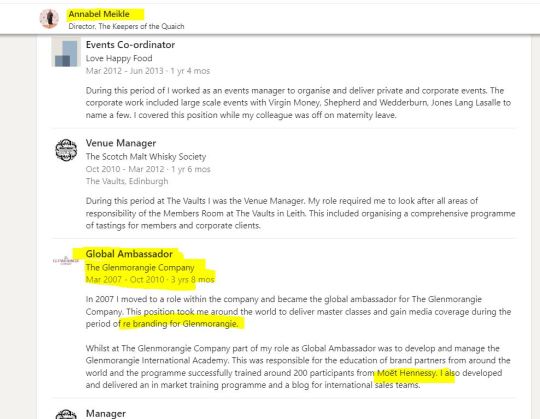
Glenmorangie (also a member of the Keepers) - keep that reference under your sleeve, we are going to need it soon :).
Could she be related to...

I am leaving this without an answer, because I don't know and I will always refuse to go data mining for anything, but that sure as hell is not a common surname, as Smith or Martin!
At any rate, Mrs. Meikle is also (along with the Duke of Argyll, the current Keepers Grand Master) a member of The Scottish Committee of something very, very prestigious: The Worshipful Company of Distillers (https://www.distillers.org.uk/), based in London and founded in 1638, by Royal Charter (for “Body Politique and corporate” to govern the “Trade Arte and Mystery of Distillers of London” - how I love history, people!) granted by Charles I, a Stuart (of course). I am speculating and having visions of Livery status and Freedom of the City, followed by Knighthood for S (no bong needed, this particular narrative writes itself and believe it or not, it's not entirely without logic). And it is my strict constitutional right to be a poetic coo about it - that guy is smarter than we thought and I would curate that contact to death if I were him (but I am not, I am just a benevolent and intrigued observer, as you all know). Back to Earth from these optimistic conjectures, I will keep a tab on it, as I dutifully took note that one of their current interests is tequila:
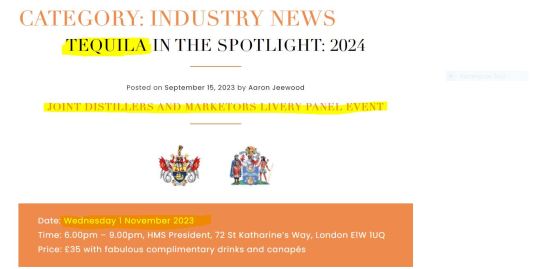
Onwards to the US. We can have a fair idea of October 4th event just by looking at one of their few press releases on the occasion of the Chapter's launch gala, on September 25 2019, in New York (https://www.distilledspirits.org/wp-content/uploads/2019/10/KOTQUSA-Release-10.04.19.pdf - with quotes selected by me):


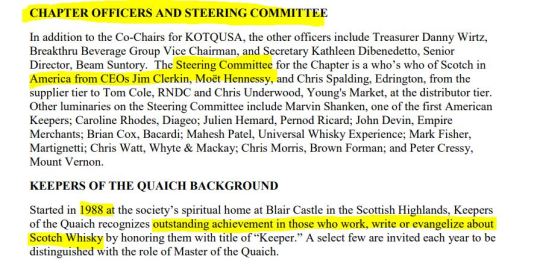
Moët Hennessy. Another reference to keep under our sleeve, for it will be soon very relevant. So yes, what has been speculated by Miss Marple is partially true: more business than aristocratic. But this is only if we do not consider as American aristocratic the venue of the next event. The Metropolitan Club is a very East Coast, WASP old money and (well, technically yes) Republican (but not MAGA Republican and this, to me, is very important for some reason) organization:
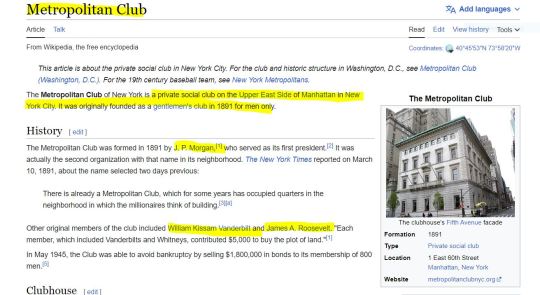
That was the state of play on Friday, folks, and I was already excited to share my optimistic findings with you. And then, C went to Paris and more dots started to speculatively connect. Bare with me for this long passegiata, I think it's worth it.
It was particularly important that C would be seen in a very friendly-casual pose with Delphine Arnault, out of all the other people attending that event. Not because Arnault is currently the big boss of Dior and Loewe (as I already explained here: https://www.tumblr.com/sgiandubh/729801825900953600/city-of-lights?source=share). And not only because C suddenly seems very interested to renew and expand her fashion days' old network. But also, because, as I already said, Delphine Arnault is also the daughter of her father and in France, business and family are always closely entwined. Always.
The French luxury market is roughly split between two behemoth players: Bernard Arnault (LVMH Moët Hennessy • Louis Vuitton S.A) and Antoine Pinault (Kering, ex- Pinault-Printemps- Redoute). These people and their businesses are number 1 and 2, respectively, on the global market. And out of these two, the only one very interested in the alcohol business is Arnault (Pinault does not deal in this sector).
So I took a look at his very diverse alcohol and spirits brand portfolio (25 references - https://www.lvmh.com/houses/wines-spirits/): rhum, brandy, champagne, tequila, wines (Argentina and even China). Two Scottish whisky brands: first Ardberg (the graceful peat from Islay). And - oh, hello, Mrs. Meikle - Glenmorangie, acquired by Arnault in 2004, after a bitter battle with Pernod Ricard (https://www.nytimes.com/2004/10/21/business/world-business-briefing-europe-france-scotch-maker-acquired.html):

Back at Mrs. Meikle's CV - hers was a pivotal role in the post-acquisition reshuffle, as part of LVMH:
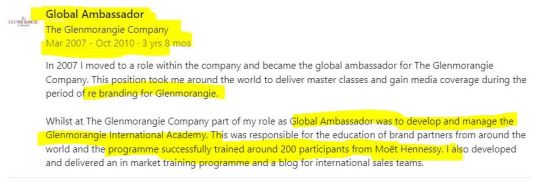
Coincidence? I think not.
And then also a bourbon reference. Woodinville (based in the state of Washington, USA) with a pitch that made me grin again like the Cheshire Cat:

Sounds familiar? Rings a bell? See a pattern? You should: no, it's not S in disguise, but it could be SS in a couple of years, if S decided to sell it for a hefty profit.
But I was also interested in what is missing from this catalogue.
NO GIN.
Who knows? Maybe these French people could be enticed? In that case (and remember: I am SPECULATING), it would have to be a brand with a proven track record. You see, Arnault is famous for always buying only brands with a proven history and proven recognition (Tasting Alliance, anyone? LOL). Up until now and as is, FMN is just a pet project and a virtual endeavor. Nothing more and we shall see. But that little wild Scottish gin which could win hearts and already an award in Frisco is something completely different.
Now, then. You connect the dots. You draw your own conclusions. I see something very intriguing here and, as I already told you, the business underground situation is completely different from the bland façade.
You see, this is not about papers or checking a pulse or awkwardly grabbing a fist on some stairs. This is show me the money time. This is all about finding unexpected connections, at a very high level and on a very narrow niche.
So you think S and C can't stand each other anymore?
Humbug. They have each other's back from Day 1. And more. Ship on, ladies. Whatever clownery these days might bring, I know what I know. And by now, you should start asking yourselves the real questions, not if Waldo is with Carmen Sandiego (we KNOW), nor if they were online at the same time or not. I mean, that's cute: but to be honest, I think we're past that... uh... waypoint?
Next on my list is that Lallybroch trademark thing. This is the most complex one and I will take my time. I may speculate, but never without a logical base. And I always take these things very seriously.
Keepers of the Quaich, indeed. :)
247 notes
·
View notes